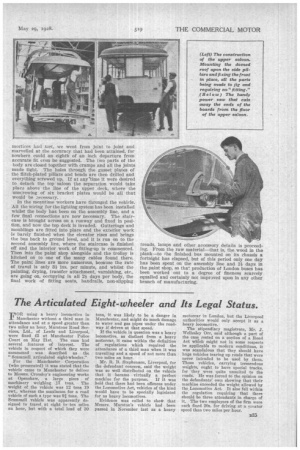The Articulated Eight-wheeler and Its Legal Status.
Page 53

If you've noticed an error in this article please click here to report it so we can fix it.
FOR using a heavy locomotive in Manchester without a third man in attendance and at a speed greater than two miles an hour, Marstons Road Services, Ltd., of Leeds and Liverpool, were fined £5 at Manchester Police Court on May 21st. The case had several features of interest. The vehicle in respect of which they were summoned was• described as the " Scammell articulated eight-wheeler," For the Manchester Corporation '(who prosecuted) it was stated that the vehicle came to Manchester to deliver to Messrs. Crossley's engineering works at Openshaw, a large piece of machinery weighing 17 tons. The weight of the vehicle was 12 tons 19 cwt., whereas the maximum for a road vehicle of such a type was 91 tons. The Seammell vehicle was apparently designed to travel at eight to ten miles an hour, but with a total load of 30
tons, it was likely to be a danger in Manchester, and might do much damage to water and gas pipes under the roadway if driven at that speed.
If the vehicle in question was a heavy locomotive, as distinct from a heavy motorcar, it came within the definition of regulations which required the attendance of a third man when it was travelling and a speed of not more than two miles an hour.
Mr. It. B. Stephenson, Liverpool, for the defendant concern, said the weight was so well distributed on the vehicle that it became virtually a perfect machine for the purpose. If it was held that there had been offences under the Locomotive Act, vehicles of the kind would have to be specially legislated for as heavy locomotives.
Evidence was called to sho* that Messrs. Marston's vehicle had been passed. in November last as a heavy motorcar in London, but the Liverpool authorities would only accept it as a heavy locomotive.
The stipendiary magistrate, Mr. J. Wellesley Orr, said although a part of the case rested on a section of a Road Act which might not in some respects be applicable to modern conditions, it was scandalous that they should have huge vehicles tearing up roads that were never intended to be used by them. Those vehicles, carrying tremendous weights, ought to have special tracks, for they were quite unsuited to the roads. He was forced to the opinion on the defendants' own showing that their machine exceeded the weight allowed by the Locomotive Act. It also fell within the regulation requiring that there should be three attendants in charge of it. The two employees of the firm were each fined 20s. for driving at a ft-reater speed than two miles per hour.




































































































